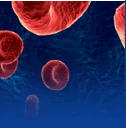 |
 Stem
Cells Stem
Cells  Red
Blood Cells Red
Blood Cells  White
Blood Cells White
Blood Cells
 Platelets Platelets
 Plasma Plasma
 Blood
Types & Activity Blood
Types & Activity
 Bloodology Bloodology

 |
 |
| Red Blood Cells, Platelets (stained purple),
a T-Lymphocyte white cell (stained green), and a Monocyte white
cell (stained gold) as seen through a scanning electron microscope.
©2000 Dennis Kunkel, Ph.D. |
The scientific name for red blood cells is erythrocytes. They are
formed in the bone marrow and are created by a stem cell. Red cells
are the most numerous of all blood cells in the blood. They are
produced at a rate of 4-5 billion every hour in an adult human!
When a red cell matures, it ejects its nucleus before entering
the bloodstream.
But that's only half the trip! After they deliver the oxygen, the
red blood cells pick up a waste product called carbon dioxide, known
as CO2. Then they make the return trip back to the lungs
through the veins where the CO2 can finally be released.
The body eliminates carbon dioxide every time we breathe out! Then,
the red blood cells start the trip all over again.
 |
 |
Rory Says: "If you're
wondering how long it takes to accomplish a round-trip... it
takes, on average... only 30-45 seconds! We, red blood cells
have a life span of about 120 days. Then we are removed from
circulation by an organ called the spleen." |
|
|
|
|
 |

|
 |
 |
 |
 |
The hemoglobin
makes the blood cells red. 
|
 |
—
Gerardo,
high school student |
 |
 |
|
 |










